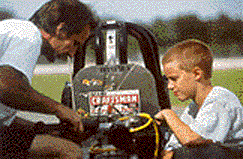
For the rebuilding facility familiar with typical automotive or heavy-duty engines, the small displacement, four-cycle, air-cooled engine may seem insignificant. After all, these one-cylinder motors, which may produce just 5 hp, are found in lawn mowers, rototillers and kiddy go karts, for cryin’ out loud!
Although the small four-cycle engines from Briggs & Stratton, Tecumseh, Kohler, Honda and others may indeed be found in the backyard sheds of America’s homeowners, the likelihood that they’ll be found on racetracks, too, keeps getting greater every day. That, say parts and equipment suppliers, means the potential for profits is huge.
"But from a lawnmower engine?" you may ask. Before you simply dismiss these tiny dynamos as unimportant to your bottom line, consider these facts.
• The price to grind a small-block Chevy crankshaft is about $75 (depending on your locale) and may take about 45 minutes. A one-cylinder Briggs & Stratton crank can be ground for nearly $30 or more in less than 10 minutes.
• A 5-hp Briggs & Stratton engine-equipped dirt track kart can reach speeds of 50 mph. Junior dragsters can top speeds of 90 mph in sub-seven second 1/8-mile runs.
• A competitive dirt track go-kart racing engine may cost upwards of $25,000 – a price its owner may feel completely at ease justifying.
"The big use of these motors is lawn maintenance," confirms Dave Monyhan, Goodson Shop Supplies, Winona, MN. "But the fun use is in junior drag racing, karting and mini tractor pulling. We recognized early on that these engines need attention too!"
Times were, the machining tools and equipment needed to service automotive engines needed to be significantly different than those used in smaller motors. That created a natural – and often wide – separation between the two markets. "But dimensionally speaking, everything kind of crashed into each other," says Monyhan. "Now, each of the five valves in each cylinder of the new $70,000 Saab has the same stem diameter as the valves in a Suzuki motorcycle."
The point is, small displacement motors offer several attractive benefits to machine shops willing to invest in the effort to not be "just another mower repair place."
In the past, rebuilders may have been too busy to bother going after the small engine business. "Let’s face it though," says Carl Amundsen, ARC Racing, Albany, GA, "the automotive machine shop business is probably half of what it used to be. It’s a consolidating market.
"But, say a shop that used to have 10 employees and now has five is looking at ways to stay afloat," says Amundsen. "It’s worth investigating the air-cooled market, and an introduction to that market is through racing."
Little cars, big-time speeds
"The biggest boost to small engine builders has been the junior dragster programs," says Brian Carlson, Carlson Racing Engines, Linden, IN. "Five or six years ago, there weren’t a lot of options available, because there weren’t very many aftermarket suppliers of parts. Now, just about any component available for a small-block Chevy is available for a 5-hp Briggs motor."
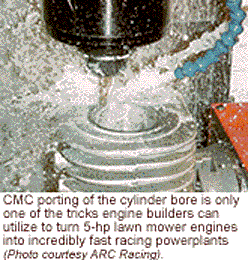
Thousands of children ages 8-17 participate in National Hot Rod Association (NHRA) and International Hot Rod Association (IHRA) junior drag racing programs. These programs feature 1/8-mile racing using a Christmas tree start and dial-in indexes.
The most powerful engines – found in the 8.90 class run by 10- to 17-year-olds – can produce more than 35 hp and speeds in excess of 80 mph in the 1/8th-mile.
The power increases have been dramatic – and predictable – since junior drag racing was first introduced in 1992. "When we first started supplying parts to this market, we’d take the $165 motor you could buy from Briggs & Stratton, add a clutch and put it on a frame," says Amundsen. "You could get into racing for less than $2,000. The kid would leave the starting line and complete the 1/8th mile in 15 seconds at about 33 mph.
"Within a year, times had dropped to 11 seconds and speeds were up over 55 mph. Today, a full-blown, well-prepared Briggs motor for drag racing goes out the door for $7,000 and is capable of sub 7-second runs at 80-90 mph," Amundsen says.
Obviously, this can result in some dramatic differences in on-track speeds. What began as an attempt to get kids interested in the sport has developed into something more – real racing, with all of the engine building tricks common in the big leagues. Jeff Giovino, NHRA technical services, estimates that just 25 percent of the junior dragster racers run a stock motor; most of the race teams make significant modifications to the stock block.
The NHRA rules specify that the engine for these cars be a standard configuration 5-hp flathead. Briggs & Stratton is currently the dominant engine for junior drag racers, but according to Giovino the rules now allow other manufacturers that offer standard 5 hp flatheads to compete as well. Only Tecumseh has this engine now.
"The rules state that the engine block must be kept in its original 5 hp configuration," explains Giovino, "but it can be bored, stroked, ported, polished — the block can be relieved — whatever the builder wants to do. There’s no maximum horsepower limit, as long as it originates in a 5 hp configuration."
The Briggs & Stratton Raptor is a race-only motor that lends itself to modifications. This motor, now in its third version, has a much heavier casting in the cylinder area, making it stronger and able to withstand much larger overbores.
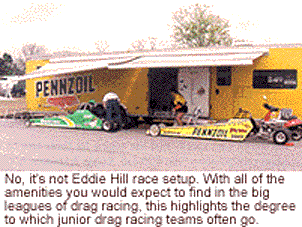
For even more radical modifications, Briggs & Stratton has introduced the "Blockzilla" block which accepts all of the parts available for the Raptor, but is even more able to produce amazing horsepower. Blockzilla’s features include revised and optimal intake and exhaust tracts as well as extra room for big bore and big stroke configurations.
"People are not afraid to spend money," says Amundsen, "They’re not going to complain about having to spend $75 for Magnafluxing and a valve job on a pair of 350 Chevy heads. Junior drag race participants are coming in with a one-cylinder block and they will literally pay whatever it takes to get what they want – and they have the money in their pockets."
ARC sponsors the annual spring "Gritz Blitz" junior drag race at Silver Dollar Raceway in Reynolds, GA, which draws up to 225 cars from more than 1,000 miles away. Amundsen says the amount of money families spend to compete in the sport is amazing.
"It used to be that you couldn’t sell a chassis for more than $2,000. Now, people are spending over $5,000 for the chassis, and $3,000 for the car’s paint job," he says. "Then, they’ll spend $100,000 for a trailer to take them to the race. In many cases, junior has his main car, he has his backup car, and then, just in case the local track will allow it, he has a car that will go real fast. Oh yes, the people have the money, and they love to spend it."
Because neither NHRA nor IHRA put severe restrictions on the types of modifications that can be made to competition engines, racers with fewer financial resources may be priced out of the game. While acknowledging that the sport has become less affordable to be truly competitive, Admunsen says that the sport is just mirroring its large-vehicle cousin. "It’s just a matter of how much you’re willing to pay to win."
Karting – not for kids only
In contrast to the "no-holds-barred" opportunity facing race teams and engine builders in the Junior Dragster market, go-kart racing is much more restrictive – but no less popular or profitable.
Organized racing in the U.S. is sanctioned by three major bodies: the World Karting Association (WKA), the International Kart Federation (IKF), and the Karters of America Racing Triad (KART). In addition, there are many independent clubs and tracks that race by local rules. Today’s racing karts are highly sophisticated machines capable of reaching speeds up to 150 mph. Kart racing is pure open wheel racing that captures all of the sensations and thrills of motorsports.
The leading karting sanctioning body, WKA, requires that vehicles competing in its stock class meet very precise technical specifications. According to one engine builder, this can be confusing to the uninitiated.
"Between the two types of racing, if you go to a kart shop and then go to a drag racing shop, even though both are building on a Briggs & Stratton engine, probably not even three parts will interchange," says Larry Snyder, Snyder Motorsports, DeMotte, IN. "Technically speaking, the Blockzilla is the most popular block in junior drag racing, but you can’t even run it in most go kart classes – it won’t meet their specs."
Snyder explains that there is a huge difference between the modifications that can be made and the components that can be used. "Both are 5 hp Briggs & Stratton engines," he says, "but they’re not the same."
These restrictions make WKA racing very competitive, which puts racing in the hands of the racers. Still, Carlson says that’s just fine with him. "We all have our own little tricks, but any reputable engine builder in the country will be within two-tenths of a horsepower with his competition. Out of a 5 hp engine, we’ll be able to develop 8.2 to 8.4 hp."
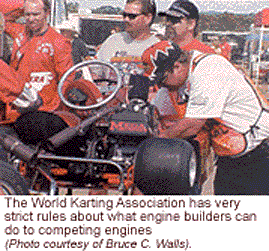
Because WKA tech officials tear down the top three engines at each national event, attention to specifications is critical. It’s also a great profit opportunity, says Carlson. "Ninety percent of our business is in stock WKA engines. The other 10 percent is in junior dragsters and Limited Modified and Open Class karting engines. Those classes are pretty much anything goes, and so that’s where the expensive pieces come in, i.e., billet and forged cranks, titanium retainers, double valve springs, aluminum billet flywheels – it can get pretty crazy."
On its informative Web site (www.worldkarting.com), WKA updates its technical specifications regularly. Rule updates covering everything from chain drive systems, valve seat angles and installations and bore and stroke specifications are posted to keep competitors and technical inspectors apprised of the latest changes.
Although restricted in what they can and cannot do, engine builders are not forbidden from "tweaking" the engine for WKA competition. Typically, Carlson explains, blueprinting the engine will involve several precise procedures including setting the cylinder bore 90° to the crankshaft, cutting the valve seats, installing aftermarket valve guides and installing a ground cam. Other modifications usually include changing from gasoline to alcohol, and changing the stock Briggs muffler.
"We’ll do some machine work as well," says Carlson, "including milling the head down to the minimum per the rules; we cut the deck so that we have the maximum amount of piston pop-up. We’ll add aftermarket rings, bore the carburetor out – basically, we try to squeak as much out of them as we can and still be legal.
"We do a lot of plateau honing – the newer rings we’re using seat into the engine a little quicker," Carlson continues. "As far as valve seats go, they have to be single angle, so there’s not much we can do there. We use carbide cutters, but you have to be real careful. I’ve seen guys use stones on the valve seats and when the stones aren’t true, they’ll cut with a little bit of a taper and the racer will get dinged in the tech barn."
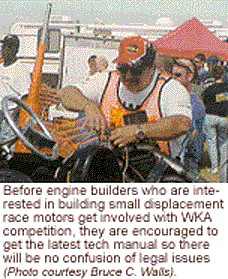
If you’re concerned because of the restrictive nature of the WKA rules that there may be limited opportunity for growth in this market, don’t be. According to Kart Marketing Group of Wheaton, IL, karting is a $1.6 billion annual industry in the United States. With more than 100,000 active karters and over 1,800 drag strips or oval, dirt or road-style race tracks, there will continue to be domestic interest in racing.
There’s so much interest, in fact, that Carlson builds small engines so he can race big ones himself. The former Purdue University math major races a portion of the World of Outlaws Gumout Sprint Car Series, and owes the ability to continue to do so to four-cycle Briggs & Strattons.
"Our schedule is to do 300 to 350 builds per year, about 1-1/2 engines per work day. Out of that number, 80 will be new engines. Obviously, three-quarters of my business involves rebuilds and repeat customers," he says. "We have two flow benches and a dyno, and we do a lot of R&D work, which gives us an advantage over some facilities. If a new customer is unhappy with his current builder, we can dyno the engine and see what we’re starting with."
Several of Automotive Rebuilder’s contributing editors are involved in small engine work as well. Joe Mondello, Mondello Technical School, Paso Robles, CA, teaches a course on the Briggs & Stratton 5 hp racing engine plus he does extensive research on Briggs racers.
Mondello’s school has a state-of-the-art NASCAR-type dyno cell on-site that is capable of handling 100 hp and 90 lbs. of torque on any single- and most dual-cylinder engines. "This allows us to keep our racers up to date with the best and latest products at good prices so they can continue to make horsepower, torque and have longevity to their engines," says Mondello (for more information about Mondello’s dyno capabilities, see "Hot Heads," Automotive Rebuilder, August, 2000, page 27).
Paul Savadin, Paul’s Crank Shop, Devine, TX, does not build complete race engines, but creates one-cylinder crankshafts for them and recognizes their attractiveness and profitability. "At age 53, I can appreciate the advantages of working on a smaller crank over a larger one. The smaller cranks take fewer chemicals to clean; they take less shot and time to shot peen them; they take less time to weld and less filler rod, many times for the same welding price as a large shaft. The smaller shafts are, all around, more pleasant to work on." (see "Cranking Out Performance for the Lawn Rangers," Automotive Rebuilder, November 2000, page 42).
Although Savadin specializes in cranks, he recognizes that the opportunities don’t stop there. "The work on these small engines doesn’t stop with crankshafts," he says. "They need to be bored, and sometimes sleeved. There are valve seats and guides that need to be replaced, too. There are many machining jobs that require a mill or a lathe. There is also a need for welding. Damage to an engine block or head will require a TIG machine to weld aluminum or use of a pinning procedure to make the repair. Welding may also be needed on other things such as the chassis."
Because the work on these little blocks is frequently identical to that on larger engines (though at a much smaller scale), most engine shops already have most of the equipment needed to participate in this market. Of course, having the equipment and having the skill may be two different things.
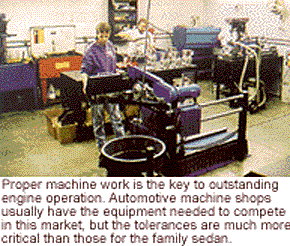
"You can’t just go into the engines and start machining and grinding like you would for a Saturday Night Special stock car," cautions Carlson. "If you’re going to work on WKA engines, you need to get a tech manual and really study it – or even go through the WKA tech seminar and become accredited as a tech person."
Building small racing engines offers phenomenal possibilities, but requires a significant commitment as well, says Carlson. "The biggest things shops need to remember is that this isn’t eight cylinders, it’s one. If you’re off a half-thousandth from one cylinder to the next on ring end gap or cylinder clearance on a 350 Chevy, it will never show up on the dyno. If you’re off a thousandth or half-thousandth on a Briggs engine, it’s the difference between a winning engine and a middle-of-the-pack motor. Tolerances are critical – there’s no room for mistakes.
Future market potential
Those who contributed to this article see the market for small engines continuing to grow. Because emissions regulations have or soon will force the elimination of 2-stroke recreational motors, 4-stroke replacements will be more common. But rather than just be a market unto itself, the small-displacement engine may offer something the engine rebuilding market has been searching for a long time – a way to get kids interested in engines again.
Larry Snyder supplies complete engine kits to his customers. The kits include a CNC-ported block, valve seats, sleeves, as well as all of the components needed to assemble a race-prepped engine. "Most kids today don’t even know what the parts are," he explains. "I don’t necessarily think they need to be rebuilding the motor themselves, but they should know what’s in the motor they’re driving down the track. Then, when it comes time to freshen the motor a the end of the season, I think the kid should be standing right there with Dad, learning how it all works."
Carlson agrees that getting kids into racing now will likely mean future interest as well. "The big thing about karting (and junior drag racing as well) is that you can get the kids into the pit area. If they’re allowed in the pits they can get involved and you can begin to teach them about engines."
Additionally, racers can learn another valuable lesson – the importance of building business relationships – at a young age.
According to Johnny Reid, Nervo-Coggin Racing, Tallmadge, OH, "The kids are learning how to get sponsors at age 5. It might just be Grandpa, but by the time they’re 15, they’ll have been learning about sponsorships and how to talk to people. It will help them make that next step in racing, which is a big one."
Twenty years ago, says Reid, a child didn’t have the opportunity to learn about racing in this way. Goodson’s Monyhan agrees.
"In the old days, people would grow baseball players and football players. Today, parents are trying to grow the next Jeff Gordon," Monyhan says. "Mom and Dad want Jimmy and Julie to be the fastest kids. Mom’s the team manager, Dad’s the crew chief, the other kids are the pit crew. They buy a motorhome, they get a trailer and it’s a total family sport. Dad gets to gear out, Mom gets to be in charge and all the kids get to eat fast food!"
The benefits offered by participation in the small-displacement engine market are evident and the opportunities are plentiful, say the experts. But still, getting past the size of the motors can be a challenge.
"For some guys, who are used to diesels or V6s or V8s, to all of a sudden say ‘Okay, I’m going to rebuild small engines…’ – it can be a real comedown," acknowledges ARC’s Amundsen. "Sure, you could look at it as rebuilding lawn mower motors – or, you could look at it as doing $10,000 a month in air-cooled racing engines. It’s your choice."













